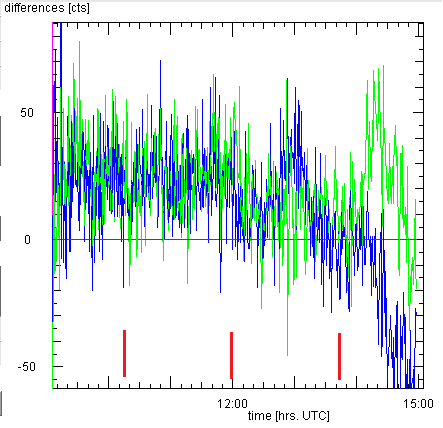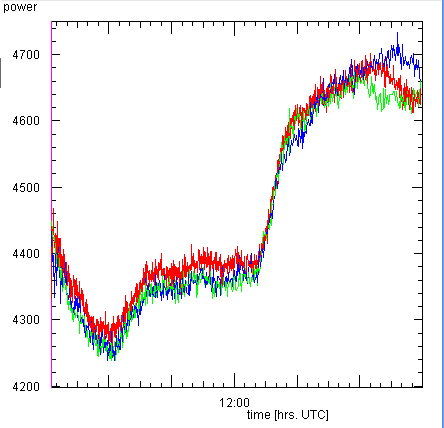
|
To capture the weak radio noise from the Moon on a wavelength of 21 cm, the
beamswitching technique is used: The telescope is pointed to the Moon, then
to the empty sky left of the Moon, then back to the Moon, then to the sky on
the right hand side, and so on ... Everytime the telescope points to the Moon,
it receives noise slightly higher than when it points to the sky. The plot
shows the difference between the Moon and the sky to the left (blue) and to
the right (green). While the signal level itself amounts to about 4500 counts,
there exists a genuine difference of about 30 counts, which is only 0.07 percent
of the signal. The plot shows that before UT 12:00 there is always such an
excess signal, and the same from the sky measureument at either side, despite
the appreciable fluctuations of about 10 counts.
The three red marks indicate the first contact of the Moon with the Earth shadow,
the time of maximum eclipse, and the last contact with the shadow. Until maximum
eclipse the signal remains constant, so that the obscuration of the lunar surface
by the shadow has no effect on the radio noise level, hence on the lunar surface
temperature. Unfortunately, after maximum eclipse the signal gets unstable most
probably due to an increase of the local electronic noise level (see below).
|

|
This tracing of the measured signals at the Moon (red), to the left (blue), and to the
right (green) shows that at about UT 12:30 the signal level increased quite rapidly.
Such a drastic change indicates an increase of electronic noise. In the data there
is no evidence for any radio interference by distinct signals, as it may happen at times.
The telescope pointed high in the sky, and not to the nearby observatory building which
contains computers. Their presence would have been obvious by their spectral signatures.
Thus, there is no identifyable cause for the rise of electronic noise, it just happens
as it sometimes does!
|